Breguet Br. 1050 Alize. French carrier-based anti-submarine aircraft
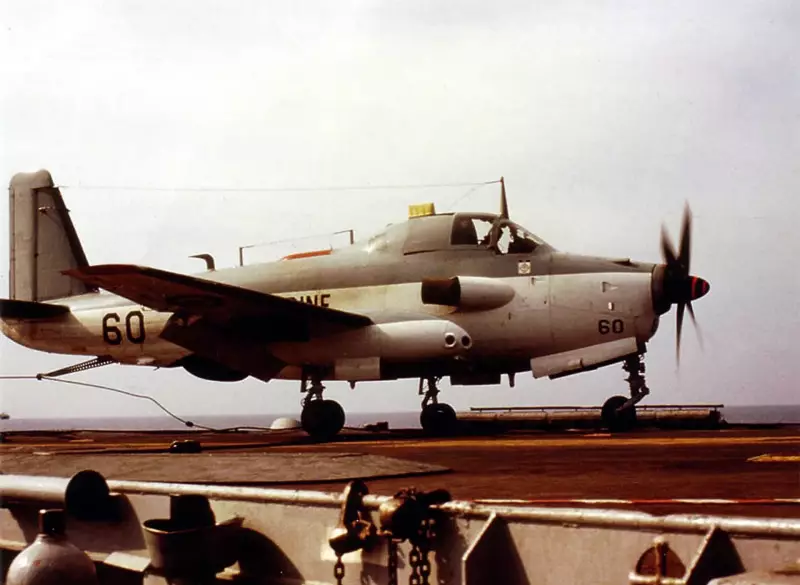
Breguet Br.1050 Alizé
History patrol aircraft dates back to shortly before the First World War, in which aviation showed its competitive advantage over airships. The tasks assigned to aircraft of this class include anti-submarine and anti-ship warfare, as well as search and rescue operations. And a lot of aircraft saw the light of day, which can safely be classified as patrol aircraft, each of which had an interesting and extraordinary history.
One of the first was the French “flying boat” FBA Type A and the Types B and C, similar in their assigned tasks. And effectively performing the functions of reconnaissance and combating German submarines during the First World War, he was able to launch the development of patrol aircraft in many countries , including in the Russian Empire, which purchased 30 type C aircraft with the Gnome Monosoupape engine (100 hp), and built 34 more at the plant of Vladimir Aleksandrovich Lebedev. Since 1915, the French FBA Type C were replaced by the Russian M-5 designed by D. P. Grigorovich.
As time passed, the aircraft industry developed, new power plants appeared, and aircraft became capable of carrying more payload and over longer distances. The Second World War ended, after which a new historical period began. Countries that previously dominated the entire world gave way to others. Weapon, which previously seemed necessary for victory, has now given way to another.
In this atmosphere, the creation of a new aircraft began in France, performing the same tasks as the FBA Type A/B/C.
So, today we will look at the history of a carrier-based aircraft with a rather unusual, but popular design for patrol aircraft of the 1950s - the Bréguet Br.1050 Alizé.
Our story begins on November 12, 1947 from another plane. Then the French naval aviation issued a specification for an attack and anti-submarine aircraft capable of carrying aircraft and depth charges, guided missiles, rockets, and torpedoes, the main feature of which was the ability to take off from the deck of an aircraft carrier.
And the creation of an aircraft carrier fleet for France has been discussed since the mid-1940s. Obviously, for the French fleet to be competitive, they must also include patrol and anti-submarine vehicles. And at a certain point in time, they converged on four aircraft carriers with a displacement of 20 tons in two stages, which resulted in two ships of the Clemenceau class, namely Fosh and Clemenceau itself, which in the French Navy were supplemented by four more different aircraft carriers.
The plan also called for the construction of a third Clemenceau-class aircraft carrier, serial number PA58, between 1958 and 1960, but this ship was finally canceled in 1960.
Another ship that was supposed to strengthen the French carrier fleet was the Verdun, developed in the 1950s, which was supposed to be slightly larger than the Clemenceau (standard displacement 35 tons). This aircraft carrier in its essence anticipated the famous flagship of the French fleet, called Charles de Gaulle.
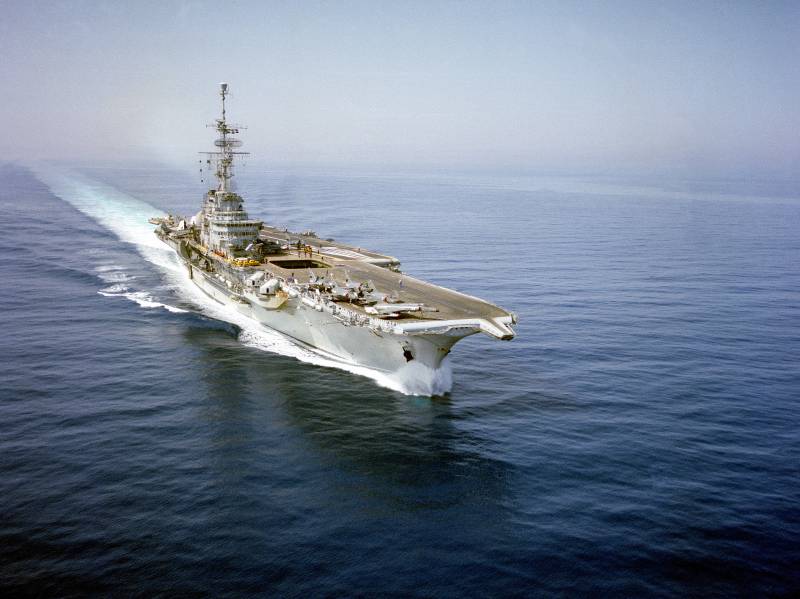
Aircraft carrier Fosh
Optionally, the future aircraft would be able to use rocket boosters to facilitate takeoff from the deck of an aircraft carrier. It had to be able to operate for four hours above sea level and reach speeds of 300 to 700 kilometers per hour. Its landing speed was assumed to be in the range of 155 km/h, and the crew was protected by more durable armor.
This specification was sent to the leading aviation companies in France, from which Breguet was selected. However, this company recognized that the speed requirements were inconsistent and could only be met by a hybrid powerplant, combining an Armstrong Siddeley Mamba turboprop engine in the bow with a Hispano-Suiza Nene turbojet engine in the tail. The company received approval for their design, and the aircraft they created was named Breguet Br. 960 Vultur (translated as “Vulture” or “Vulture”).
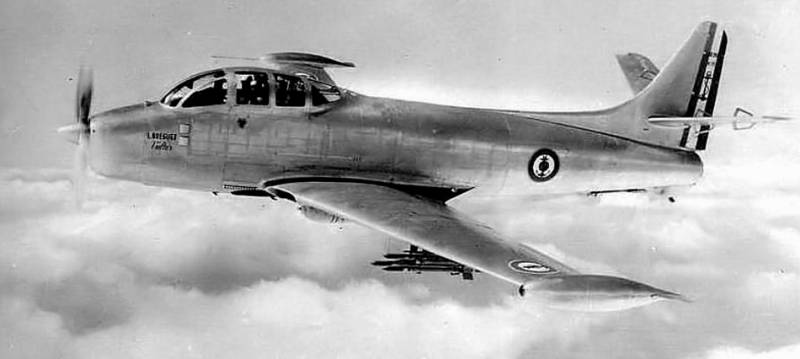
Breguet Br.960 Vultur
It was a low-wing aircraft with an oval-shaped supporting fuselage and a tricycle landing gear. Its two-spar wing had a swept leading edge and a straight rear one, in the vertical folding of which, and this is one of the conditions for operation on aircraft decks, hydraulic mechanisms were used.
The tail had the same sweep and an angle of 16°. The fuselage had a 600 liter self-sealing fuel tank and a 350 liter self-sealing tank in each outer wing panel. The crew consisted of the ship's captain and co-pilot, seated side by side in a frame canopy.
A year after the specification was created, Breguet received an order for two prototypes.
August 3, 1951 Br. 960 Vultur took off for the first time from Toulouse-Blagnac. The first prototype's power plant consisted of an Armstrong Siddeley Mamba I turboprop engine at the front, producing up to 970 hp. s., the low consumption of which was supposed to provide up to nine hours of patrol, and the Hispano-Suiza (later Rolls-Royce) Nene 101 turbojet at the rear, with a power of 21,6 kN, to which air was supplied through ducts in the wing roots to have additional power in if necessary. In particular, the jet engine was relevant when taking off from the decks of aircraft carriers or during air combat.
The second prototype flew on September 15, 1952. It was equipped with a more powerful Mamba III engine producing 1 hp. With. Small nacelles were installed at the tips of its wings; the port one contained a 320 liter (100 imp gal; 22 US gal) unprotected fuel tank, and the starboard nacelle housed the attack radar. A more powerful power plant was necessary, since the first prototype, on the contrary, turned out to be so underpowered that it could not be flown with a full combat load without the jet engine running.
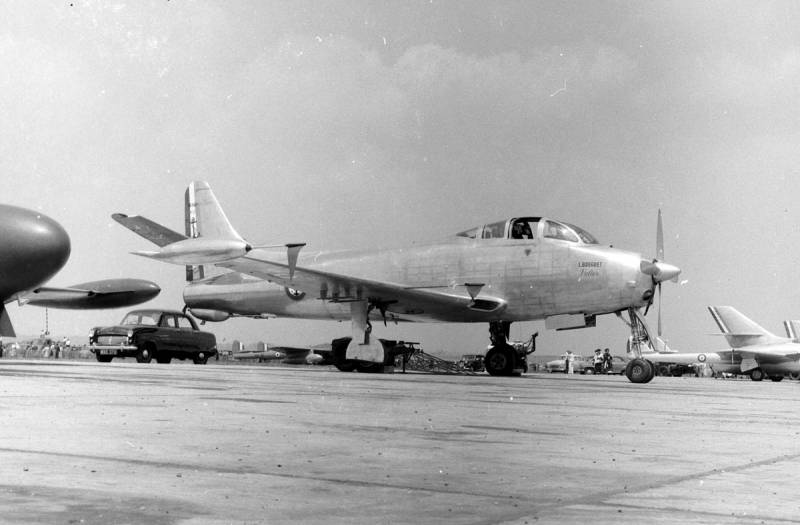
And if the first prototype showed poor flight characteristics, the second aircraft met all the specification requirements and demonstrated satisfactory carrier ejection and landing qualities, which were tested at the Royal Aircraft Establishment at Farnborough airfield in early 1953.
At that time, the installation in France was not equipped to evaluate such qualities of naval aircraft. The first prototype was later modified for other tests. Engine air is blown through slots in the upper surface of the wing designed to increase lift. It was named Breguet Br. 963. The third prototype was used to conduct simulated ground launch and landing tests.
The aircraft was equipped with a fulcrum under the fuselage that could carry a payload weighing up to 1 kg. Under the wings were four launchers, each of which could carry two missiles. In addition to the bombs, the ventral hardpoint was equipped to accommodate a more powerful search radar in a container.
As a result, the Vultur reached a maximum speed of 850 km/h. Thanks to a sophisticated lift system, this aircraft could land at a specified speed of 155 km/h.
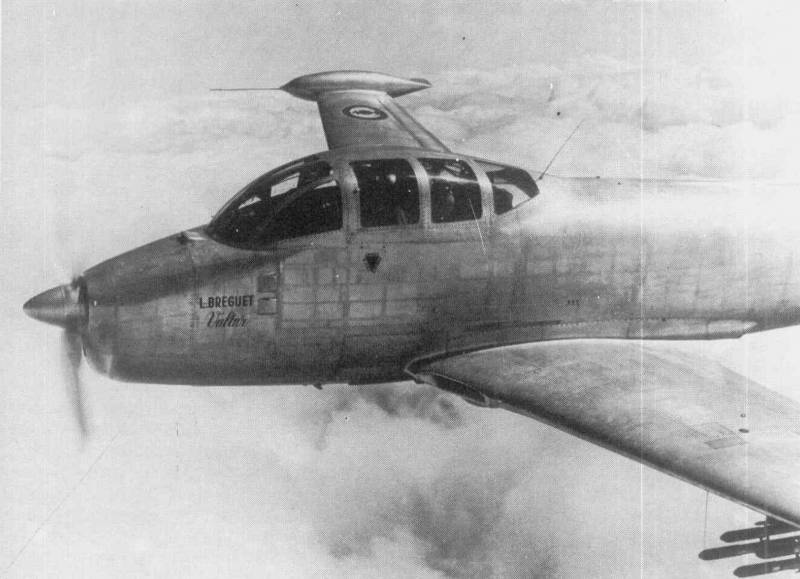
In 1953–1954 The French Navy lost interest in the Breguet Br. 960, but continued to be interested in the idea of purchasing a specialized anti-submarine platform. Meanwhile, the concept of the French Navy was changing in favor of the so-called hunter-killer or (literal translation) “hunter-killer”. An example of such a concept was the reconnaissance TBM-3W Avenger, operating in parallel with the anti-submarine TBM-3S Avenger, which was in service with the French fleet at the time.
In other words, the new vision of the French Navy is characterized as “see-destroy,” for which aircraft with a strong on-board radar were ideally suited, even if it was the failed TBM-3W Avenger in many areas. To achieve this, it was decided to adapt the Vultur platform for anti-submarine warfare and for long-range fleet cover tasks, rather than creating a completely new aircraft.
Not only does Br. The 960 turned out to be a very good aircraft that promised high efficiency in the army, and it was just a matter of banal savings, because they spent accordingly on the program, and it would be sad if it all went down the drain.
In addition, Tu-91, Fairey Gannet, Douglas A2D Skyshark and Short SB. The 6 Seamews seemed to be quite good aircraft, and their design was quite reminiscent of the Breguet Br. 960.
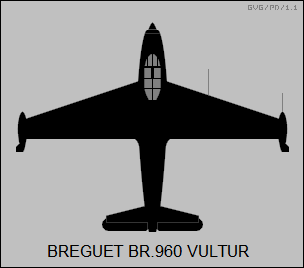
First of all, Breguet decided to find new options for modernizing its already obsolete Breguet Br. 960. It all started with the most obvious proposal to upgrade the Vultur into what the Aeronavale is asking for - a “hunter-killer”. The plan was to produce an aircraft very similar to the American Grumman AF Guardian, only one version was equipped with a ground search radar, and the other had a larger bomb bay for more weapons.
The chassis of this version was also different and similar to that found on the Grumman AF Guardian, that is, with two main legs in front of the center of gravity and a small wheel at the rear to support the vehicle. This version was called Breguet Br. 960F1, and it was created in parallel with another modification - Breguet Br. 960F2, which was equipped with a chassis similar to that which appeared on the Breguet Br.1050 Alize.
Another interesting version was the Breguet Br. 961 is an aircraft free of a folding wing, a landing hook and other nuances of a carrier-based aircraft. This vehicle would be equipped with one 30-mm air cannon in each wing. In this modification it was offered to the French Air Force, but they were not too interested. And this version of the aircraft fell into oblivion.
But Breguet's more comprehensive and thorough response was to modify the second prototype into a demonstrator. The Nene jet engine has been removed and its exhaust pipe plugged. The turboprop engine was upgraded to the more powerful Mamba VI. This engine was also installed on the British Short SB anti-submarine carrier-based aircraft. 6 Seamew, which is usually compared with the Breguet Br. 1050. An AN/APS-15 retractable search radar was installed in the fuselage, and both wingtip nacelles were removed.
Now the pilot sat in front on his left, the navigator sat to his right, and the sensor operator sat to the side behind them. Additional fuel tanks replaced engine ducts and wheel arches in the inner wing sections, and the landing gear was modified to retract forward into large nacelles on the leading edges of the wing. The trailing edge of the wing was no longer straight, so the plane now had a trapezoidal wing. Now known as Br. 965 Épaulard (Killer Whale) it made its first flight on 26 March 1956 and was the immediate predecessor of the Bréguet 1050 Alizé.
It’s interesting that initially they wanted to name our today’s hero exactly as his prototype was called – “Killer Whale”, but later the name was reworked, as was, in fact, the numerical index, which, continuing the given Breguet Br. 960 numbering, should have been designated Breguet Br. 966.
One way or another, a new aviation program has now begun to create an aircraft based on the developments of the Vultur, but which still differed in small details from the Breguet Br. 1050 Alize.
Before building the prototype, Breguet conducted a significant number of aerodynamic experiments on models and samples of the aircraft, made in scales 1:8, 1:2,5; 1:16 and 1:20. During the purging of the aerodynamic layout of the car, many changes were made. Thus, the width of the tail was increased and the height of the tail was changed, the profiles of the width of the wing and nacelle fairings into which the main landing gear were retracted were selected. Steering, aileron and closed areas were also found on the models. The adjustments made allowed us to prevent more changes after flight testing.
Another important issue regarding the design of the Breguet Br. 1050, which required discussion before creating prototypes, was the selection of the best engine position. Breguet engineers encountered this while working on the Vg. 960, so the problem was not so acute.
As a result, the engine should not extend beyond the contours of the fuselage in order to provide good visibility to the pilots. In addition, it was necessary to maintain the operational characteristics of the aircraft when based in the limited space of an aircraft carrier.
They did not immediately decide on the location of the gas outlet. On the first prototypes, the exhaust pipe carried the exhaust gases to the right side of the fuselage, under the wing, but the hot air reflected from the flight deck caused a lot of trouble for the maintenance personnel. These, of course, are not airplanes with vertical takeoff and landing, the engines of which hit the deck with hot air during takeoff no worse, but it’s still an unpleasant feature of this machine. On experimental aircraft with numbers 03, 04 and 05, the exhaust pipe from the engine was placed above the wing. This solved the problem and the right side exhaust pipe became an exclusive feature of all Alize series.
On the plane, in the part of the fuselage just behind the wing, a radar antenna was installed in a large radio-transparent fairing - it was released for operation, and at high speed it was retracted into the fuselage again. This scheme, worked out on the Br. 960 ASW, which featured a design with an enlarged cabin, one Mamba VI engine and an AS 33B radar in a gondola on the left wing tip, although it made the structure heavier, was still preferable to a stationary one, because due to the relatively high aerodynamics, speed gains were obtained.
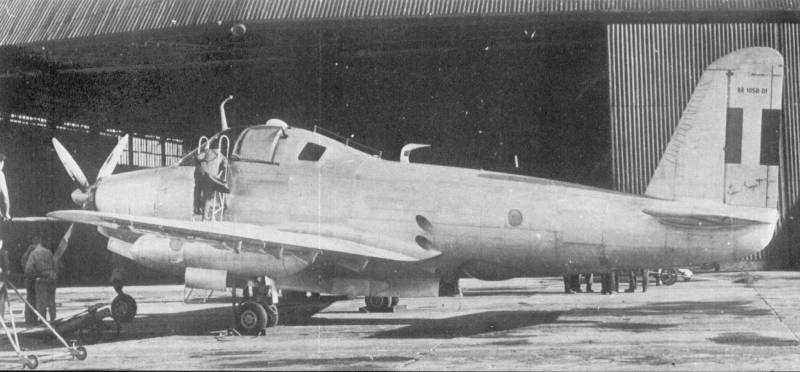
Breguet Br. 1050-01 Alize
Three prototypes (No. 01, 02 and 03) and two pre-production aircraft (No. 04 and 05) were built. The first prototype (No. 01, equipped with a Rolls-Royce Dart RDa 7 Mk 20 engine with a power of 1 hp) took off on the fifth (although somewhere they say the sixth) October 600, under the control of Yves Bruno and two other pilots, Only whose surnames are known: Lascarre and Perrineau. Then the second prototype took off on December 1956 of the following year.
They were both equipped with the American APS-33 radar, but this aircraft also featured many important design solutions that were later transferred to the production Breguet Br. 1050. It was just a retractable radar in a fairing, located at the back, where the Vultur reactor used to be located. The fuselage was modified to accommodate a third crew member, and the wings received integral nacelles along the leading edges.
On April 19, 1957, the third and final prototype took off. The original Dart Mk 20 engine was replaced by the more powerful Dart Mk 21, producing 1 hp. With. A retractable radar was installed: Thomson-CSF DRAA-950B instead of APS-2.
Ejection launch and landing tests were conducted at Bedford in England in 1957 and continued until 15 November 1957, then aboard the British aircraft carrier HMS Eagle in the Mediterranean Sea in 1958. This aircraft carrier was chosen due to the fact that the French Arromanches, on which the Breguet Br. 1050, was unavailable then, as it was sent for repairs or scheduled maintenance, opinions vary.
However, on December 2, 1958, the third prototype landed for the first time on this French Navy aircraft carrier. For operation on an aircraft carrier, the aircraft's wings were folded, so the span was reduced from 15,6 m to 7 m. In addition, catapult launches are possible without restrictions on the air route and speed at meteorological winds of less than 28 km/h.
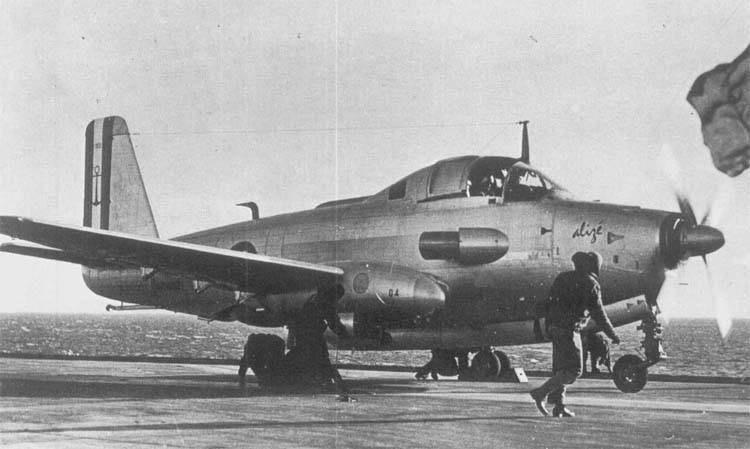
Breguet Br.1050-01 Alize
Two pre-production aircraft, No. 04 and 05, took off on June 21, 1957 and August 1, 1958, respectively. The first flights of pre-production vehicles meant that mass production could soon begin, which is what happened in our history. The Épaulard program was replaced by the creation of the Breguet Br. 1050 Alize, whose name translates as “Passat”, that is, the wind that rages between the tropics all year round, in the Northern Hemisphere from the northeast, in the Southern Hemisphere - from the southeast. A rather poetic and unusual name for a carrier-based anti-submarine aircraft, which, in my opinion, is much better than the previously proposed Killer Whale.
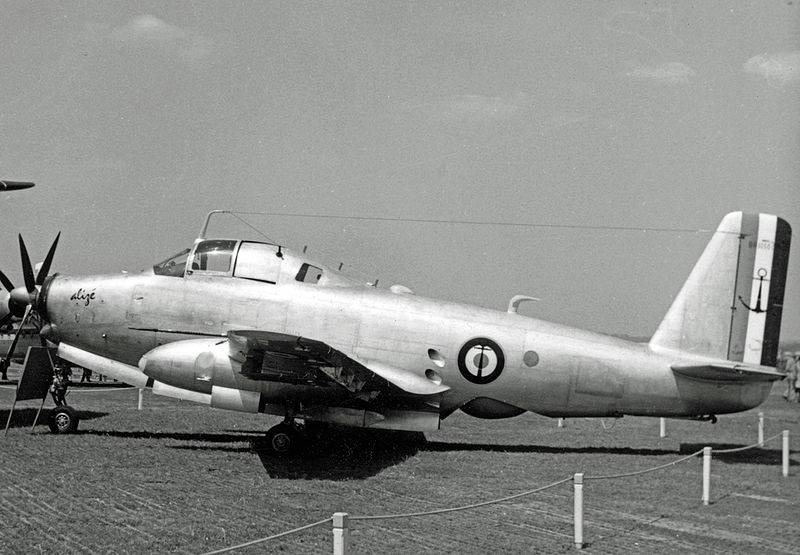
Breguet Br. 1050 Alize at Le Bourget Air Show
Meanwhile, in May 1957 for Breguet Br. 1050 Alize had a rather pleasant event - the air show in Le Bourget. That year, by the way, the USSR presented its exposition for the first time, which, in general, is the only interesting fact that I could sew into this article.
It is curious that on French websites there is information that Breguet Br. The 1050 was indeed at the Le Bourget Air Show that year, but was bypassed. Here you should either doubt the photograph that is cited as confirmation of Alize’s participation at the 1957 French air show, or doubt the French sources that ignore this photograph. In any case, Alize received its well-deserved interest among international operators, and whether this interest in the aircraft appeared before or after Le Bourget, it seems to me, is not so important.
Initially, it was planned to build 100 production copies only for the needs of the French Navy, but in 1958 this number was reduced, and 75 aircraft were eventually ordered (the first order was for 50, then the second was for 25 aircraft). And, as I mentioned, this aircraft also aroused interest in one foreign country, which ended with the purchase of Breguet Br. 1050 Alize for your needs, but before we get to that, let's take a look at the unsuccessful proposals for the acquisition of Breguet Br. 1050.
Unexpectedly, interest in the new French aircraft arose in Indonesia, which expressed a desire to purchase Alize. Indonesia was refused by a court decision, which feared the use of its aircraft in a conflict with Holland, an ally of France.
Another country whose Navy needed the Breguet Br. 1050, became Brazil, which at that time was armed with the aircraft carrier NAeL Minas Gerais. She was a Colossus-class light aircraft carrier operated by Marinha do Brasil (Brazilian Navy) from 1960 to 2001. The ship was laid down for the British Royal Navy during the Second World War as HMS Vengeance, but was built shortly before the end of hostilities, and did not contribute to the defeat of the Axis countries.
After serving as a training ship and Arctic research vessel, the aircraft carrier was leased to the Royal Australian Navy from 1952 to 1955. It was returned to the British, who sold it to Brazil in 1956. In 1960, Brazil conducted comparative tests of Vg. 1050 Alize and Grumman S2F Tracker.
Preference was given to the second, which has greater potential for modernization (by the way, all Tracker aircraft are currently still associated with the armed forces of the Brazilian Navy). And this aircraft was produced in huge quantities, at least compared to its French counterpart - 1 aircraft, not counting several other modifications, which were also produced in decent quantities.
But the country that was able to export these aircraft to its homeland was India, to which 12 aircraft were delivered in 1961, that is, at the same time as they were put into service in France.
Their service took place from the ground base of the 310 Squadron of the Indian Navy, which for a long time was based at INS Hansa - the Indian naval air base located near Dabolim in the state of Goa, India (from September 29, 2017, the squadron moved to the air base INS Sardar Patel) . It is India's largest naval air base. It has a civilian enclave that operates as Dabolim Airport. Another duty station for Indian Breguet Br. 1050 became the aircraft carrier INS Vikrant. They were operated by the Indian Navy from 1961 to 1991.
And, it seems to me, it’s worth taking a closer look at the appearance of Breguet Br. 1050 Alize in India and the history of operation of this aircraft in this country. And the decision to purchase these aircraft will be somewhat reminiscent of the creation of Breguet Br. 960 Vultur for the needs of the French Navy, which also revolved around the aircraft carrier fleet.
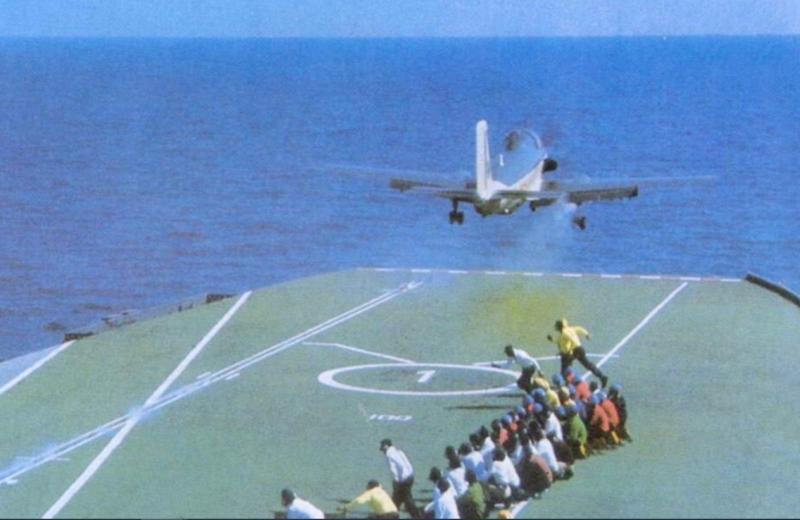
Breguet Br. 1050 Alize from INAS 310 Squadron
More specifically, we will focus on the operation of the Breguet Br. 1050 Alize in a separate article, because this topic is too broad. In the course of writing it, I had to touch upon the history of the creation of the Indian state, the history of the Indian Navy, carrier-based aviation, the aircraft carrier INS Vikrant, the INAS 310 squadron and the only combat loss of this aircraft. As you can understand: it would be strange to tell all this in an article about one little-known attack aircraft, but as an addition, helping to delve deeper into the history of this still extremely unusual aircraft, it is ideal.
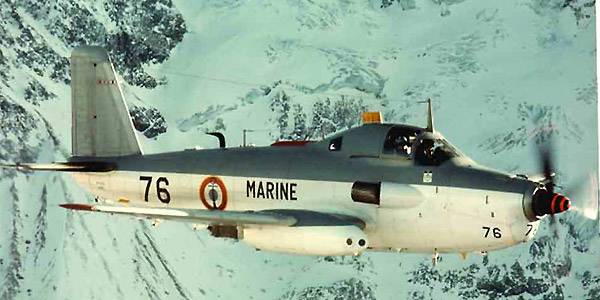
A few words about the start of operation of Breguet Br. 1050 Alize in France.
On March 31, 1959, Breguet delivered the first Alize to the French Navy. In three years, Aeronavale received the number of aircraft that were agreed upon under the contract - 75 units. On July 19, 1961, the French Navy received its last Alize.
These Breguet Br. 1050 were commissioned on the Arromanches, a British Colossus-class aircraft carrier acquired by France in 1951 and on which some of the testing took place, Clémenceau, the lead ship of the French class of ships of the same name, which was one of the flagships of the French Navy between 1961 and 1997 , and Foch, which became the second Clemenceau-class aircraft carrier to serve in the French Navy from 1963 to 2000.
At the same time, Arromanches was the only one on which takeoff and landing were primarily practiced using a catapult and a standard arresting device, respectively. On the decks they were destined to replace the American, already quite outdated Grumman TBM-3W Avenger and Grumman TBM-3S Avenger. A number of these aircraft also remained at air bases, where they were used to train new crews.
Also Br. 1050 were used to perform tasks such as communications, work with aerial targets and training of technical personnel. All transmitted Alizes received sequence numbers between 1 and 61, as well as 64, 65, 68–70, 72–77, 80, 86 and 87.
And we'll leave it at that for now.
Yes, you may think that this is not enough, but the situation here is similar to what happened with Breguet Br. 1050 Alize, owned by the Indian Navy. Most likely, I will also publish an additional article in which I will talk about the history of the operation of these aircraft in the French Navy, and about their accidents, thereby completing the long-suffering story about the combat use of these aircraft.
With this, I propose to move on to the design, performance characteristics and performance characteristics of this machine, which will no longer be abbreviated.

So, Breguet Br. 1050 Alize is a three-seat single-engine monoplane with a low wing, with a Rolls-Royce RDa.7 Dart Mk 21 turboprop power plant with a rotor speed of 15 rpm and a power of 000 hp. with, as well as from the fuel and oil fuel placement systems. The propellers of this engine are 2-bladed, constant speed reversible propeller with full feathering. A special pipe extends to the right side above the wing, removing exhaust gases from the engine. The motor frame was attached to the second (power) sealed frame. In the lower part of the nose section there was a niche for cleaning the nose landing gear strut, in which the front landing gear mounting unit was attached, which was produced for Alize by Hispano-Suiza.
The engine was installed in a four-point position on a steel tubular motor mount, mounted on a power sealed frame No. 5. The engine mounting points required rubber shock absorption. The engine supplied the injection system with a water-methanol mixture, which made it possible to regulate engine power in high temperature conditions, where the Breguet Alize was mainly used.
In the process, it turned out that this system can also handle rotation speeds within 14 rpm. The regulation system of the military version of the engine was somewhat different from the “civilian” one - it performed its functions regardless of the pilot’s choice of engine operating mode.
The fuel for the Rolls-Royce RDa.7 Dart Mk 21 is also worth noting. Aviation kerosene of brands TR-0, TR-4 or TR-5, as well as their mixtures in any proportions, was used. The total capacity of fuel tanks is 2 liters. If necessary, it was possible to carry out an emergency (emergency) drain of fuel from all tanks, subject to exceptional consumption. Fuel consumption is 100–350 liters/hour.

The aircraft wing is cantilever, two-spar, trapezoidal. The wing span is 15,6 meters, the aspect ratio is 6,8 meters. The wing installation angle is +2°30' in the center section and +1° in the end part of the wing.
Technologically, the wing was divided into three sections: a center section and two folding consoles, created to save space on an aircraft carrier. The wing center section had a span of 6,6 meters and consisted of two half-planes. Two spars, wing skin panels and power ribs formed volumes in the center section of the wing, which contained four rubber protected fuel tanks. The wing consoles fold hydraulically; the consoles' position was controlled and locked from the pilot's cabin.
The Alize has the usual mechanization: ailerons and flaps, no slats or spoilers. In this case, the flaps were located along the entire trailing edge of the wing, being alkaline, three-position, divided into four sections. Two rotating sections were installed on the wing center section and two on the consoles. What makes them “three-position” is the fact that they could be in three states: “retracted” (0°), “takeoff” (35°) and “landing” (55°). The flap span is 4,1 m. Ailerons were installed at the end parts of the wing. The aileron deflection angle is 25°. Throughout their entire span there were automatic trimmers controlled by hydraulic drive.
Behind the cockpit and on the bottom of the aircraft there was a retractable radar antenna, and the tail section itself served as the basis for attaching the fin and stabilizer, and in the first versions also the navigation system antennas. A brake hook was installed in the lower sections of the sections, necessary to simplify landing on an aircraft carrier. It was pulled out by a special hydraulic cylinder.
The power set of the tail section consisted of a number of frames and 16 stringers. A retractable radar antenna with a diameter of 1,3 m was released and retracted into the tail section using a hydraulic drive. The antenna was mounted on two steel hoops, allowing it to be fixed in any intermediate position.
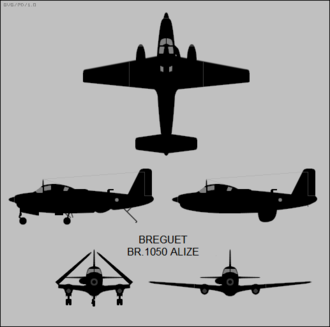
The stabilizer had a separate elevator. The tail is trapezoidal, just like the wing. The keel is double-spar. The rudder is with horn compensation. The height of the vertical tail is 2,5 meters. A controlled trimmer, divided into two parts, is located along the entire span of the rudder. The stabilizer span is 5,8 meters.
On the first pre-production aircraft, altitude and direction control were carried out without the use of servos and hydraulic boosters, but starting from Vg. 1050-04, the control system is equipped with hydraulic boosters, which reduce the load on the pedals and control handle. The same pre-production prototype also featured an updated radio antenna and fin. On Breguet Br. The 1050-04 also retained the air brake, which was eliminated with the production version.
Now I propose to move on to the performance characteristics and performance characteristics of the Breguet Br. 1050.
So:
Length: 13,86 m
Wingspan: 15,6 m
Height: 5 m
Wing area: 36 m²
Empty weight: 5 kg
Maximum take-off weight: 8 200 kg
Maximum speed: 518 km / h at an altitude of 3 050 m
460 km/h – at sea level
Cruising speed: 240–370 km/h
Range: 2 km
Endurance: 5 hours 10 minutes
Ceiling: 8 000 m
Rate of climb: 7 m / s
Wing load: 229 kg/m².
A few words about what and where this attack aircraft could generally carry.
The internal compartment could accommodate one L4 aircraft torpedo, Mk.44, later replaced by Mk.46 324 mm caliber, or 160 kg depth charges, depending on the nature of the mission. The Breguet Alize could carry up to 14 sonobuoys in its bomb bay.
Aviation or depth charges (accordingly, the Breguet Br. 1050 could carry three depth charges in the internal compartment and two on pylons under the wings, of which there were three on each folding section), as well as six unguided rockets on launchers, 68 mm missile baskets and two Nord AS.12 wire-guided anti-ship missiles on pylons on folding wing sections could be mounted on underwing pylons.
In total, the Breguet Alize could have 8 external suspension points.
Let's return to the design.
In general, the entire Alize is usually divided into sections, and not just the wing. This includes the bow (engine compartment), central (crew compartment) and tail (radar antenna compartment) sections. The fuselage had several sealed partitions that ensured the aircraft's buoyancy during a forced landing on water.
The central section was limited by two sealed power frames. The upper part of the section is occupied by the crew cabin, designed for three people. The composition included a pilot (placed in the front seat on the left front of the flight), a navigator-operator (to the right behind the pilot) and a radar operator (behind the pilot and navigator). In the cockpit it was possible to move around the cabin. So, the navigator can take the place of the operator and vice versa. Radar monitoring and tracking equipment with indicators and forecasts was installed behind the pilot and navigator's seats. The cabin floor, which divided the central section into the cockpit and the compartment, was the power structure.
Thanks to this, it was possible to achieve a large number of longitudinal force spars. The 5-meter-long compartment had two dampers driven by six-hydraulic cylinders (three shutters on each side). Here conventional bombs and torpedoes, as well as depth charges and mines, were used. In addition, it was possible to mount two additional fuel tanks in case of long operations.
Now we move on to an important part of any aircraft - the control system.
Total for Breguet Br. 1050 had two control systems: main and auxiliary.
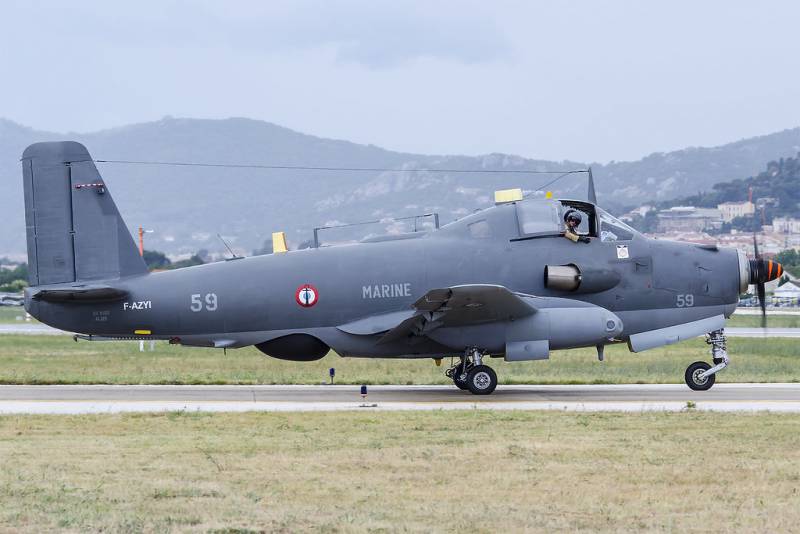
The main system was responsible for retracting and releasing the landing gear, radar antenna, opening and closing the functional compartment (bomb bay), operating the wing folding mechanism, as well as the release brake hook. The auxiliary system involved the emergency release of the hull, flaps and brake hook, as well as the emergency opening of the hatch doors and the emergency release of the cockpit glazing. If I understand correctly, this control system can also be divided into mechanical and manual.
To fire missiles, a collimator sight was installed in the pilot's cockpit. A bomb is dropped by an attack aircraft operator using his sighting system.
The Breguet Alize uses an electric flight system. Its basis is a generator-starter, operating in both generator and starter modes. Backup power was provided by two rechargeable batteries connected to the generator board.
The aircraft's landing gear is tricycle with a front rotating support. The main ones were retracted into cigar-shaped fairings on the wing. At the same time, they move forward in the direction of flight, which is quite unusual. The front parts of the fairings housed radio-electronic equipment. The main support, in terms of the structure, has already been discussed.
All racks have wheels of the same size 650x10, while the main racks had two wheels with pneumatic disc brakes, and the front one had one freely oriented one. The distance between the main pillars is 4,9 meters, and between the bow and main pillars is 4,4 meters.

Let's move on to avionics.
Breguet Alize radio equipment consisted of radio stations with VHF (ultra-short wave), HF (short wave) and MF (medium wave) bands. An on-board radiotelephone is used for communication between the air crew. The autopilot, manufactured by SFENA, will be used to relieve the crew on long patrol flights and facilitate the performance of anti-submarine missions. With the help of the autopilot, the plane could fly to a given altitude and select the desired course. Both the pilot, the navigator, and the radar operator could intervene in the operation of the autopilot.
Navigation system for detecting communication equipment with a ground control point and equipment for determining the location of aircraft. The latter appeared not only to determine the situation at any moment, but also kept a record of changes in the coordinates of the aircraft during anti-submarine missions and maritime patrols. Alize was equipped with other cognitive functions: a radio compass, a radio beacon and a TACAN short-range navigation system.
Search equipment of the DRAA 2A search and research search and navigation radar and standard equipment carried by all anti-submarine aircraft: radio acoustic buoys, interrogator-transponder, search radar, various receiving antennas located on top of the fuselage, as well as passive receiving antennas located in the front of the fairings niches for cleaning the main landing gear.
That's all, I have nothing more to say about the design.
Perhaps I could supplement this story with an even more detailed description of the Breguet Alize, based on the changes from prototypes to pre-production aircraft and from pre-production to production aircraft, and from them to those undergoing modernization. But I have already described the changes in general terms during the course of the article, and in general, calling this article “Breguet Br. 1050 Alize", I, oddly enough, planned to focus on the history of the production aircraft. And although the description of the prototypes was an integral part of this story, it was not the main task, and, as it seems to me, a relatively brief description was enough here.
One way or another, let's get to the conclusion.
And the conclusion from the history of Breguet Br. 1050 will be similar to similar conclusions from my past works.
Alize seems to me a very interesting aircraft to study and describe, which deserves to be talked about more often and more. And personally, I liked to delve into all this, to find out the history of the aircraft, which I had heard about for quite a long time, but never got around to writing a large enough article about it, in which I could try to talk about the features, nuances, interesting details that I seemed interesting.

Summing up the personal result of Breguet Br. 1050, I consider it a generally good aircraft, which was created, perhaps, in the best place for this and in the best period in this country, at least from those in which such an anti-submarine carrier-based aircraft as the Breguet Br. 1050 Alize, could be produced in large quantities.
Another thing is that the generally modest supplies of good aircraft abroad spoil the overall picture. 14 Alize for India is hardly the result that Breguet was aiming for. The same British Fairey Gannet was produced as 347 aircraft in all modifications, turning out to be the most popular aircraft among deck-based anti-submarine vehicles of a similar design.
However, someone was even less lucky: also the British Short SB. 6 Seamew was produced in the amount of 26 aircraft and left British service 4 years after its first flight. The Soviet Tu-91 as a whole was a hostage to the situation, because the aircraft carrier under which it was created never appeared, and as a result, the construction of a rather promising aircraft turned out to be impossible. Although, the car is interesting, maybe someday it will come to fruition.
In conclusion, I would like to say that Breguet Br. 1050 Alize is a rather extraordinary, albeit seemingly secondary aircraft with an interesting history. I think that soon we will begin the story of his distant relative, but more on that another time.
Information